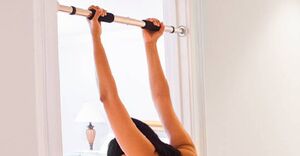
Ultimate Guide: Freestanding vs. Wall-Mounted Pull-Up Bars – Which is Better for You?
Looking to incorporate a pull-up bar into your home gym but unsure where to begin?
The various types of pull-up bars, specifically freestanding and doorway options, are examined.
The key distinctions between the two are discussed, including stability, space requirements, weight capacity, and price.
Determining which type of pull-up bar is better suited for your needs is facilitated whether you are a beginner, have limited space, are an advanced user, or are seeking a budget-friendly option.
What Are the Different Types of Pull-Up Bars?
When considering pull-up bars, it is important to understand the different types available for workout routines. Pull-up bars primarily come in two variants: freestanding pull-up bars and doorway pull-up bars.
Freestanding pull-up bars are suitable for individuals seeking a stable and versatile option for upper body workouts. They provide a variety of grip positions, allowing for different hand placements to target various muscle groups.
On the other hand, doorway pull-up bars are convenient for those with limited space or beginners looking to gradually build strength. The doorway option is easy to install and can be a good starting point for anyone wanting to improve their fitness level.
Both types of pull-up bars have their advantages and can be beneficial based on specific fitness goals and requirements.
1. Freestanding Pull-Up Bars
Freestanding pull-up bars are known for providing a stable and versatile platform for upper body workouts. These bars are designed to offer sturdy support and are often adjustable to accommodate different fitness levels.
The stability of these pull-up bars allows users to concentrate on proper form and technique without concerns about the equipment’s durability. Plus pull-ups, the versatility of freestanding pull-up bars allows for a variety of exercises like leg raises, dips, and hanging leg curls. The portability of these bars makes it easy to set up a workout station anywhere at home or outdoors, facilitating consistency in fitness routines.
For users seeking to progress in strength training and customize their workouts effectively, sturdiness and adjustability are crucial considerations.
2. Doorway Pull-Up Bars
Doorway pull-up bars are convenient fitness accessories that can easily be installed in a home. These bars are suitable for individuals looking to save space while maintaining a consistent workout routine.
With a simple set-up process that typically involves mounting the bar securely onto a door frame, users can quickly begin their pull-up exercises without the need for any complex tools or additional equipment. This makes them a popular choice for indoor workout enthusiasts who value convenience and efficiency in their fitness routines.
The secure grip provided by these pull-up bars ensures a safe and effective workout experience, helping users build upper body strength and improve overall fitness levels.
What Are the Differences Between Freestanding and Doorway Pull-Up Bars?
When comparing freestanding and doorway pull-up bars, there are several key differences to consider, such as stability, space requirements, and the installation process.
Freestanding pull-up bars are recognized for their sturdy stability, typically featuring a wider base that offers strong support during intense workout sessions. On the other hand, doorway pull-up bars, although less stable than freestanding options, provide the benefit of space efficiency, making them suitable for individuals with limited workout areas. The installation process also differs; freestanding bars generally require minimal assembly and can be positioned anywhere in a room, while doorway bars are easily mounted on a door frame, enabling quick setup without the need for extra space allocation.
1. Stability
The stability of a pull-up bar is essential for ensuring safe and effective workouts. Freestanding pull-up bars typically offer higher stability because of their construction and supportive design.
These bars are specifically designed to stand securely on their own, minimizing the risk of wobbling or tipping during intense workouts. Stability is crucial not only for the user’s confidence but also for preventing accidents and injuries that could result from instability.
A reliable pull-up bar provides a solid foundation for users to exert their strength without concerns about the bar’s reliability. A sturdy and well-built pull-up bar ensures proper support for the body weight being lifted, reducing strain on the arms, back, and shoulders. Additionally, the grip on a stable pull-up bar is improved, allowing for a firmer hold and decreasing the likelihood of slipping during exercises.
2. Space Requirements
Considering space requirements is crucial when choosing between freestanding and doorway pull-up bars. Freestanding bars are suitable for indoor and outdoor settings, providing versatility in usage. Their compact size makes them ideal for smaller indoor spaces where permanent installations may not be feasible.
You can easily relocate these freestanding pull-up bars to optimize your workout area. Their straightforward assembly process eliminates the need for drilling holes in door frames, making them a convenient option for renters or those concerned about wall damage.
Outdoors, freestanding pull-up bars are versatile as they can be placed in various locations, such as a backyard, garage, or even a park for outdoor workouts.
3. Weight Capacity
Understanding the weight capacity of pull-up bars is crucial to ensure durability and user safety. Freestanding pull-up bars are recognized for their sturdy construction and high weight capacities, making them suitable for a variety of users.
A higher weight capacity in pull-up bars not only increases safety but also reflects a stronger structure that can endure heavy use over time. By opting for a freestanding pull-up bar with a substantial weight capacity, users can have confidence in their equipment’s ability to support them during rigorous workouts without the concern of breakage or instability. This durability aspect is important for individuals with long-term fitness objectives, ensuring that the pull-up bar remains a dependable tool for enhancing strength and endurance.
4. Price
Price considerations are significant factors in choosing between freestanding and doorway pull-up bars. Freestanding bars may have a higher initial cost but offer long-term cost-effectiveness due to their durability and versatility.
On the other hand, doorway pull-up bars are typically more budget-friendly initially, making them an attractive option for those looking to save money. These bars may require additional reinforcement or installation, which can incur extra costs over time, ultimately impacting their overall value.
It is essential for users to weigh the upfront expenses against the potential long-term benefits when deciding which type of pull-up bar suits their needs and budget best.
Which Type of Pull-Up Bar is Better?
The selection of a pull-up bar option depends on several factors, such as exercise preferences, fitness goals, and targeted muscle groups. Understanding these differences can help in choosing the most suitable pull-up bar for upper body and core workouts.
Factors like grip variations, weight capacity, and adjustability are critical in determining the effectiveness of a pull-up bar routine. For individuals looking to enhance overall strength and muscle tone in the back, arms, and shoulders, a multi-grip pull-up bar with different handle positions provides a versatile workout solution. On the other hand, those concentrating on core stability and engagement may benefit more from a doorway pull-up bar that also functions as a suspension trainer, aiding in targeting abdominal muscles and improving overall fitness levels.
1. For Beginners
It is advisable for individuals new to starting their fitness journey with pull-up bars to consider user-friendly and safe options. Doorway pull-up bars equipped with secure grips and simple installation processes can be well-suited for inexperienced users.
These pull-up bars specifically designed for doorways often feature adjustable characteristics, allowing beginners to customize the equipment to their desired comfort level. Maintaining a proper grip during pull-up exercises is essential for injury prevention and effective strength building. Beginners can take advantage of pull-up bars that provide padded handles or multiple grip positions to accommodate different hand sizes and preferences. Choosing a doorway pull-up bar that can support the user’s weight capacity with a robust construction adds an additional layer of safety and stability to the workout experience.
2. For Limited Space
Space limitations require compact and portable pull-up bar solutions that can be utilized both indoors and outdoors. Doorway pull-up bars are particularly adept at saving space and providing convenience for individuals with restricted workout areas.
These pull-up bars are specifically crafted to fit into standard door frames without necessitating permanent installation, making them suitable for small apartments, dorm rooms, or any setting where traditional gym equipment may not be practical. Featuring simple setup and removal, doorway pull-up bars offer the flexibility to transition between various locations, whether it be a bedroom, living room, or even a backyard for outdoor fitness sessions.
3. For Advanced Users
Experienced users who are interested in challenging workouts with higher resistance levels might find freestanding pull-up bars with thicker bar diameters and adjustable heights appealing. These pull-up bars are designed to provide increased difficulty and can help in engaging muscles more effectively during exercises.
Moreover, those looking to enhance their strength training routine should also explore pull-up bars that offer multiple grip positions to target different muscle groups. The availability of various grip options allows for a more comprehensive upper body workout, which can contribute to balanced muscle development. Some pull-up bars may also have adjustable resistance bands that users can incorporate to intensify the challenge. This feature enables users to personalize their workout experience, making it suitable for those who are aiming for progressive overload and continual improvement in their fitness journey.
4. For Budget-Friendly Option
For individuals seeking budget-friendly workout solutions, comparing the advantages and disadvantages of freestanding and doorway pull-up bars can assist in making an economically sound decision. It is important to weigh the initial cost against the long-term benefits to determine the most cost-effective option.
Freestanding pull-up bars, while initially more expensive, offer versatility and stability for a variety of workout routines. They enable the performance of a range of exercises beyond just pull-ups, increasing the value of the investment.
Conversely, doorway pull-up bars are typically more affordable and convenient, particularly for those with limited space. However, they may have weight restrictions and could potentially cause damage to door frames if not installed correctly.
Assessing these factors in relation to one’s budget and fitness objectives is essential for identifying the most cost-effective pull-up bar option.
External resource : https://nutroone.com/en/product/standing-pull-up-machine-2/




No Comments